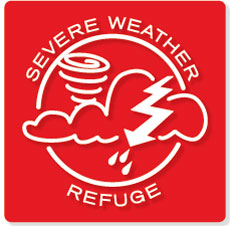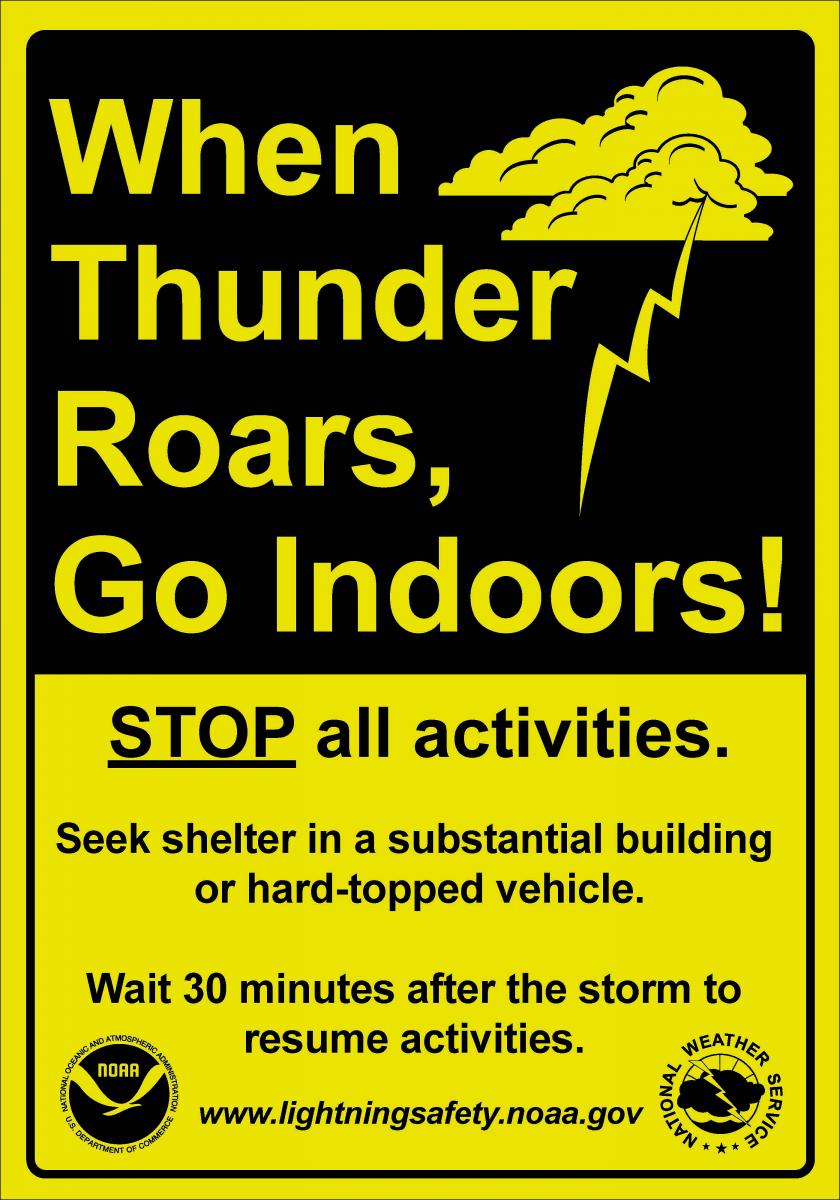Severe Weather
Tornadoes and severe weather can occur at any time. The best plan is to learn about community resources now, before weather events strike. If you take time to think through what to do in advance, you’ll be better prepared to take care of yourself and those around you during an actual emergency, until help arrives.
Tornado
Take these precautions in the event of a tornado or dangerous winds (55 mph or greater).
- If you are indoors on campus, move to a Severe Weather Refuge location on campus or the lowest level of a building, in an interior room or hallway, keeping away from windows. The locations are marked with the Severe Weather Refuge logo.

- If you are outside, seek shelter immediately on the lowest floor of a sturdy nearby building, keeping away from windows.
- If no shelter is available, lie flat in a nearby ditch or depression and cover your head with your hands. Flying debris causes most fatalities and injuries associated with a tornado.
- Being in a vehicle offers little protection. Go to the lowest floor of a sturdy nearby building (keeping away from windows) or lie flat in a nearby ditch or depression and cover your head with your hands.
- Be aware of falling debris and power line hazards.
Severe Thunderstorms and Lightning
No place outside is safe when a thunderstorm is in the area. Get inside as soon as you hear thunder. Move to a substantial building or hard-topped metal vehicle as quickly as you can. If you can’t get to a safe building or vehicle:
- Avoid open areas. Don’t be the tallest object in the area.

- Stay away from isolated tall trees, towers or utility poles. Lightning tends to strike the taller objects in an area.
- Stay away from metal conductors such as wires or fences. Metal does not attract lightning, but lightning can travel long distances through it.
- If you are with a group of people, spread out. While this actually increases the chance that someone might get struck, it tends to prevent multiple casualties, and increases the chances that someone could help if a person is struck.
Storm Ready
Emory was Georgia's first university to earn a “StormReady” designation from the National Weather Service for developing a proactive response plan to better prepare the campus community for severe weather events. To earn the designation, a community or campus must:
- Establish a 24-hour warning point and emergency operations center;
- Demonstrate more than one way to receive severe weather forecasts and warnings and to alert the public;
- Create a system that monitors local weather conditions;
- Promote the importance of public readiness through community seminars;
- Develop a formal hazardous weather plan, which includes training severe weather spotters and holding emergency exercises.
Preparing for Ice, Snow, and Freezing Temperatures
Risks associated with extreme cold include hypothermia and frostbite.
Safety tips include:
- Stay dry; wet clothing speeds the loss of body heat.
- Stay covered; use mittens or gloves and a hat to prevent heat loss.
- Dress in layers; air trapped between loose layers helps to insulate your body.
- Keep a winter weather kit in your car with items that you may need if you become stranded on a roadway: blankets, water bottles, a small shovel, and kitty litter (for traction on ice).
- In addition to the risk that extreme cold brings to people and animals, cold temperatures can also cause problems with frozen pipes that may lead to the loss of water pressure and ruptured pipes.
- In the event of a utility failure, do not attempt to correct the problem yourself. Immediately notify Emory Police at 404.727.6111 or call Campus Services during regular business hours (8:00 a.m. to 5:00 p.m.) at 404.727.7463.
Dangerous Heat
Risks associated with extreme health include heat exhaustion, heat stroke, and dehydration.
Safety tips include:
- Drink plenty of fluids, stay in an air-conditioned room, and stay out of the sun.
- Wear lightweight and loose-fitting clothing when possible.
- Take extra precautions if you work or spend time outside. When possible, reschedule strenuous activities to early morning or evening. Know the signs and symptoms of heat exhaustion and heat stroke.
- To reduce risk during outdoor work, schedule frequent rest breaks in shaded or air-conditioned environements.
- Move anyone overcome by heat to a cool and shade location.
- Children and pets should never left left unattended in vehicles under any circumstances.
- Heat stroke is an emergency! Call Emory Police at 404.727.6111 or dial 911
Storm ‘Watches’ and ‘Warnings’: What to Do
Find additional information in the “Just in Time” guide.
Be PreparedEmory Weather Stations
Emory hosts three of the twelve sites that comprise the North Georgia Lightning Mapping Array. Lightning data is an additional tool used by the National Weather Service to assist with early warning decisions for dangerous thunderstorms and tornados.
The Severe Storms Research Center (SSRC) at the Georgia Tech Research Institute (GTRI) has developed and deployed the North Georgia Lightning Mapping Array (NGLMA). The NGLMA uses 12 very high frequency (VHF) sensors, distributed around the metropolitan Atlanta region, to measure “total lightning” in electrical storms.
